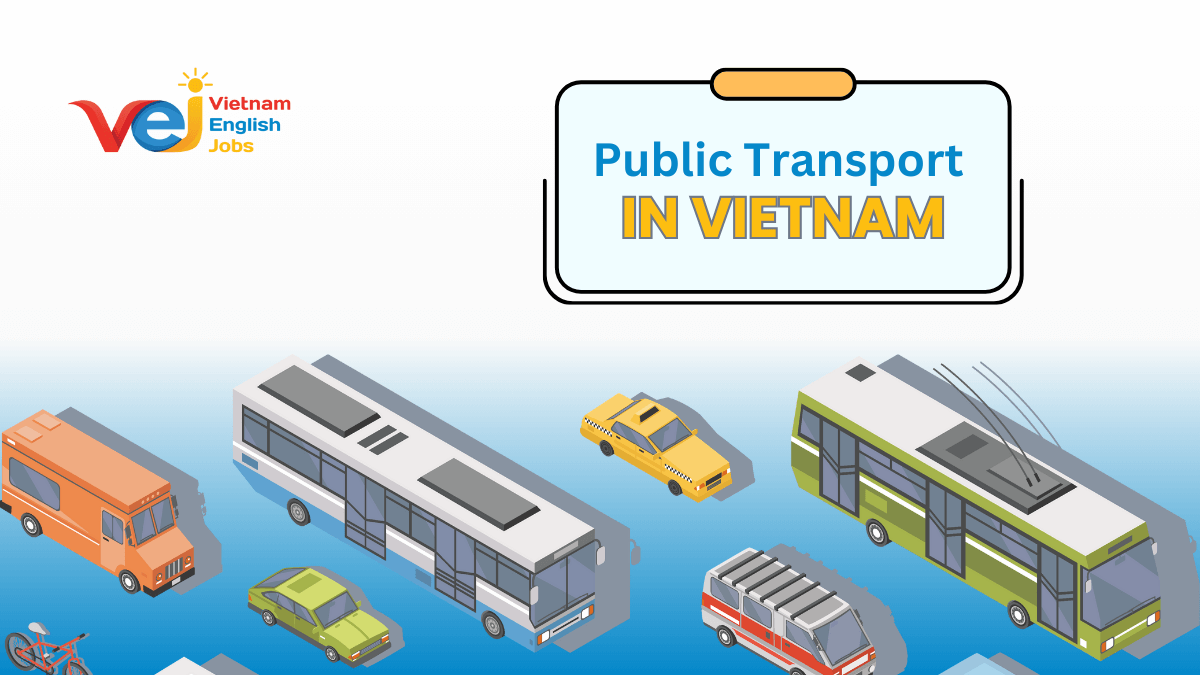Public Transport in HCMC, Hanoi, Da Nang: A Guide for New Foreign Teachers
For new foreign teachers in Vietnam, one of the first challenges after arriving is learning how to get around. While many expats eventually rent a motorbike, public transport in Ho Chi Minh City (HCMC), Hanoi, and Da Nang is becoming increasingly convenient, safe, and budget-friendly. Whether you’re commuting to class or exploring the city on weekends, here’s a complete guide to help you navigate Vietnam’s main cities.

Public Transport in Ho Chi Minh City (HCMC)
1. Buses
HCMC has an extensive bus system with over 100 routes covering most districts. Fares range from 7,000–10,000 VND. The BusMap app is highly recommended for real-time schedules and route planning.
- Pros: Cheap, reliable routes to universities and suburban areas
- Cons: Can be crowded, slower during rush hour
2. Metro
The long-awaited HCMC Metro Line 1 (Ben Thanh – Suoi Tien) has already begun operation. This metro line connects District 1 with Thu Duc City, passing through major hubs such as the Saigon Hi-Tech Park and Suoi Tien Theme Park. It is a fast, reliable alternative to buses and motorbikes.
3. Electric Buses
Recently, VinBus (VinFast – Vingroup) and Phương Trang (Futa Bus Lines) introduced electric buses in HCMC. These buses are modern, eco-friendly, equipped with air-conditioning, Wi-Fi, and GPS systems. They are part of the city’s effort to move towards green and sustainable transport.
4. Ride-hailing Apps
Most teachers prefer using Grab or Xanh SM (VinFast’s EV ride-hailing service) motorbikes and cars. These services are affordable, reliable, and available 24/7.
Public Transport in Hanoi
1. Buses
Hanoi’s bus network is large and affordable, with fares starting from 7,000 VND. Popular routes connect the Old Quarter, universities, and suburbs like Bac Ninh. The Timbus app is useful for checking routes.
- Pros: Cheapest way to get around, wide coverage
- Cons: Traffic congestion affects timing
2. Metro
Hanoi’s first metro line (Cat Linh – Ha Dong Line) opened in 2021, connecting the city center with western districts. Tickets cost 8,000–15,000 VND, making it a fast and affordable choice for teachers living near the line.
3. Electric Buses
Hanoi is leading Vietnam in adopting electric buses. The electric bus system is operated by VinBus (VinFast – Vingroup). In addition to VinBus, other operators such as Transerco, Newway, and Bảo Yến are beginning to deploy VinFast’s new electric buses. These buses run on multiple routes, connecting both central and suburban areas, offering quiet, eco-friendly, and comfortable travel. They include features like real-time GPS, automatic stop announcements, and air-conditioning.
4. Ride-hailing Apps
Grab and Xanh SM motorbikes/cars are the most commonly used ride-hailing options for teachers. Prices are reasonable and services are available throughout the city.
Public Transport in Da Nang
Compared to HCMC and Hanoi, Da Nang is smaller and easier to navigate. While many teachers choose to ride motorbikes, public transport is available.
1. Buses
Da Nang’s bus system is smaller compared to Hanoi and HCMC but still useful. Routes connect the city center with the airport, beaches, and neighboring Hoi An. Ticket prices are around 5,000–30,000 VND depending on the distance.
- Pros: Cheap, less crowded than HCMC/Hanoi
- Cons: Limited routes, longer wait times
2. Electric Buses
Da Nang has also introduced VinBus electric buses on select routes, making eco-friendly transport more accessible to teachers and locals alike.
3. Ride-hailing Apps
Grab and Xanh SM are widely available. Many teachers rely on them for quick commutes to school, the beach, or the airport.
*Tips for New Foreign Teachers
- Use apps: Google Maps, BusMap (HCMC), Timbus (Hanoi), and Smart Bus (Da Nang) make navigation easier.
- Always carry small change for bus fares.
- Buy a transport card: In Hanoi and HCMC, monthly bus passes are available and cost-effective if you commute daily.
- Plan around rush hours (7:00–9:00 AM and 5:00–7:00 PM) to avoid delays.
- Metro expansion: Keep an eye on metro development, as it will change commuting patterns significantly.
- Consider safety: If you’re not comfortable driving a motorbike, public transport and ride-hailing are reliable alternatives.
- Plan around rush hours: Traffic in Hanoi and HCMC can be intense between 7–9 AM and 5–7 PM.
Public transport in Vietnam is improving rapidly, offering foreign teachers affordable and practical ways to get around. HCMC is developing its first metro system, Hanoi already has one in operation, and Da Nang is introducing smart bus solutions. With buses, metros, and ride-hailing apps, teachers can easily commute to work and explore their new home without needing to ride a motorbike right away.

















